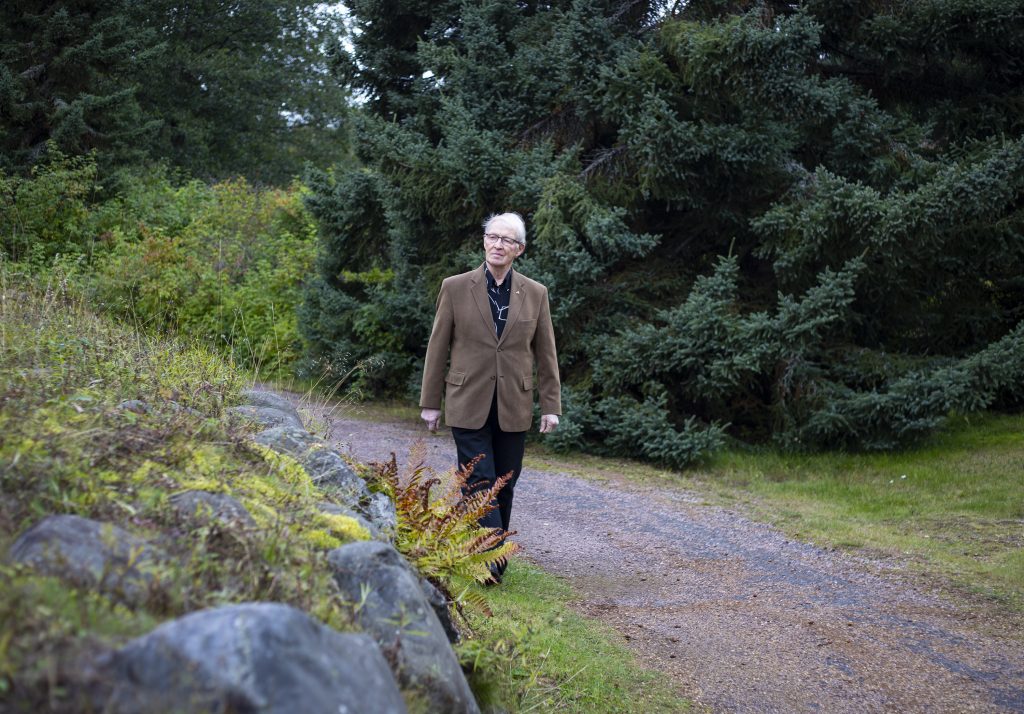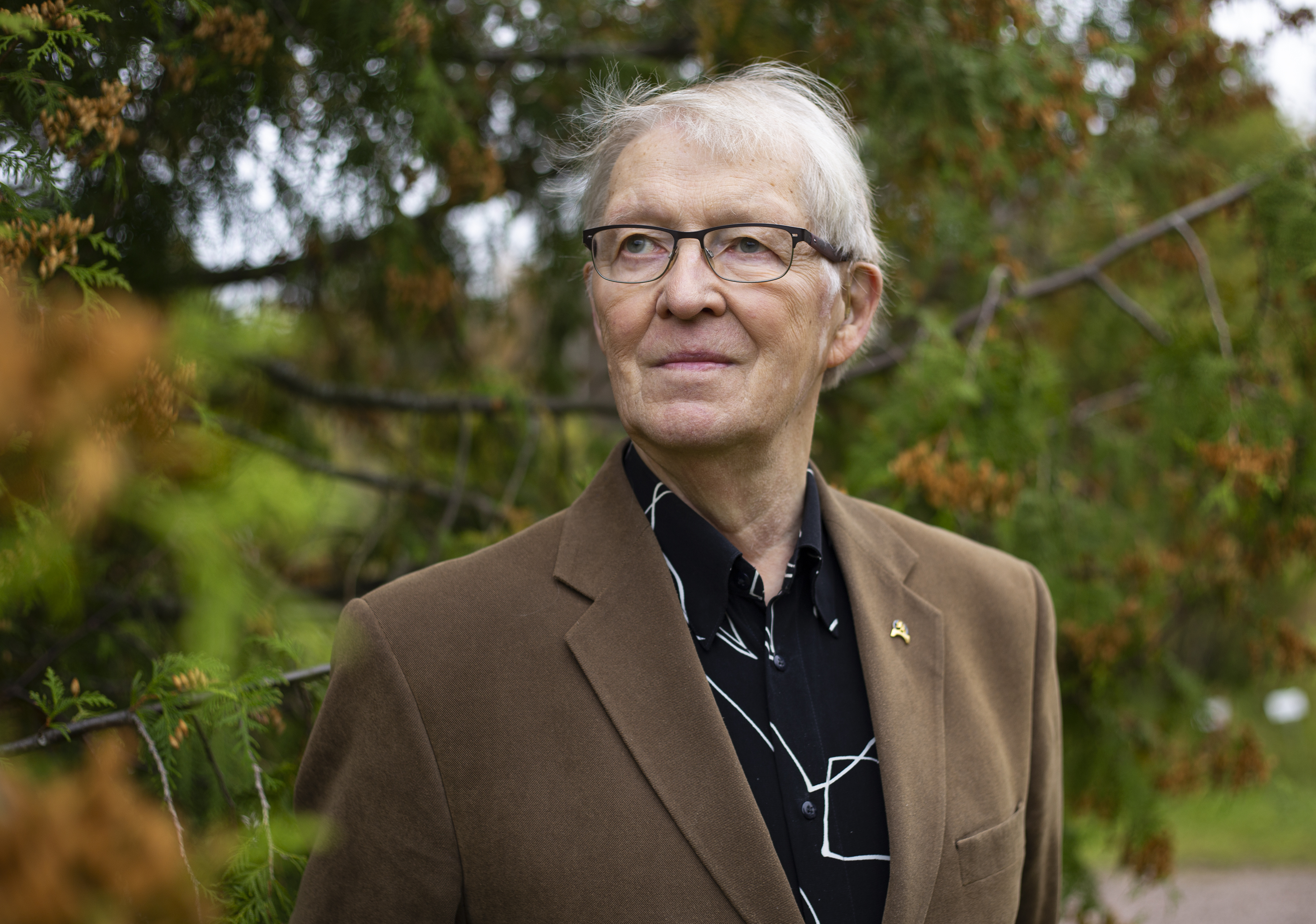On the 3rd of October 1959, a festive atmosphere prevailed in Oulu. On that autumnal Saturday, sun flashed between the clouds and thousands of people were on the streets. Flags were waiving in the poles.
The big change had arrived in the city, and now the entire Oulu celebrated. The act on the University of Oulu was signed on 8 July 1958, and a bit over a year later it was time for the first opening ceremony of the university.
The largest meeting room in the city, YMCA’s tennis hall, was full of festive people. City orchestra sat on a raised platform, and the guests sat side by side on the rows of seats. Among the guests were Speaker of the Parliament Johannes Virolainen, Prime Minister V. J. Sukselainen, Member of Parliament and former Minister of Education Kerttu Saalasti, academicians Martti Haavio and Kustaa Vilkuna, as well as Bishop of the Diocese of Oulu Olavi Heliövaara.
Whether minister or academician, the dress code guided the guests for festive attire: white tie or lounge suit, for women dark short gown without a hat, decorations.
As the opening ceremony began, a parade of academicians, university chancellors and rectors, as well as the university’s temporary council, acting professors and assistant professors. The crowd stood up, the orchestra played Erik Tulindberg’s minuet, and the parade arrived in the hall led by Pentti Kaitera, the first Rector of the University of Oulu. The President Urho Kekkonen and his wife Sylvi Kekkonen, Governors Kalle Määttä and Martti Miettunen with their wives, and adjutants arrived in the hall accompanied by Porilaisten marssi march. After Pentti Kaitera’s opening presentation, the guests heard greetings from Minister of Education Heikki Hosia and professor Edwin Linkomies, the Rector of the University of Helsinki.
YMCA’s hall was completely full, the floor was covered with rows of seats, and those who didn’t get a seat stood in the balconies and stairs leading there.
Matti Kauppi wasn’t one of them. Like many others, he, too, followed the opening ceremony from a TV in the hall of Oulun lyseo, a couple of hundred meters from the actual ceremony.
Unlike many others, he had a different connection to the university: in a couple of days he would begin his studies as one of the first 424 student in the University of Oulu.
Home through the forest
Matti Kauppi, originally from Kempele, heard about the new university in the spring 1959 while he was still serving in the military in Pohja Brigade in Oulu. In August, he attended in the entrance exams for biologists in all three subjects: botany, zoology, and geography. After the exams, Kauppi got the news: welcome to the University of Oulu!
His interest in nature and its wonders manifested already as a schoolboy. While other school kids in Kempele chose the fastest way home along the road, Kauppi and his friend preferred a walk through the forest. Later in life, the friend became gardener while Kauppi became biologist.
When the University of Oulu began its operation sixty years ago, it formed two faculties: philosophical and technical. Oulu Teacher School, established already in 1953, merged to the university, and the medical faculty started in autumn 1960.
Soon after the opening ceremony, Kauppi got to know the student life in Kasarmintie 7, where currently resides the art museum. The top level of Åström’s office building was rented for the botany and zoology departments of the University of Oulu.
Kauppi still owns the study register where all completed exams and lectures were marked by hand. First marks are from the beginning of October in 1959, when professor Lauri Siivonen began the course in animal morphology.
Teaching was in forms of lectures and courses. According to Kauppi, the courses took more time then than nowadays: one course could be three hours in a week and last through the whole winter. The days were full: courses and lectures spanned from the morning to late afternoon with only break for one or two hours. Because the students didn’t have their own restaurant, they either brought their own lunch or cycled to the city centre to the industrial school in Albertinkuja.
The young University of Oulu received much from the earlier universities. Its professors came from Helsinki and Turku, and the old brass Leitz microscopes came from Helsinki. During the first year, the professors brought their own samples for teaching purposes. This had to be done, otherwise the young biologists wouldn’t have anything to study.
The course assistants also collected and preserved the plants also by drying them and preserving them in formalin. Moulds were cultivated on a bread under a glass cover and algal fungi even with fly carcasses.
The study materials had to be prepared for microscopes, which means that the sample had to be processed for study, Kauppi reminisces. For example, when studying plants, the student had to pick up a sample from the preservative liquid and cut very thin pieces of the sample for studying. The most vivid memory from the first courses was the terrible smell of plants and animals preserved in formalin. Then again, Kauppi became a skilled cutter thanks to constant cutting exercises with razor blades.
At the end of the term, a written exam was held at the end of each course. This was then marked with grade in the student’s register. There were no study credits or points to collect, and guidance for theses was quite minimal in the beginning. According to Matti Kauppi, students worked on their theses mostly independently, at times also by banging their heads in the walls when they had done unnecessary work due to the lack of guidance.
The relationship with the professors was very formal, Kauppi recalls.
“Professors were [addressed as] Misters. We students were also Misters and Misses, but professors were to be addressed highly respectfully – but not as Mister Professor.”
Kauppi’s study week was six days long. Monday and Tuesday were reserved for zoology, Wednesday and Thursday for botany, Friday and Saturday for geography.
Was studying in the new university hard? How stressful was studying back then?
According to Matti Kauppi, he did sit in the lectures like everyone else. After all, the lectures were essential. Not because students’ participation would have been closely watched, but because otherwise they wouldn’t know what was talked about during the lecture. There were no separate hand-outs, unless some other student was kind enough to duplicate their notes with tracing paper. Kauppi preferred courses over lectures, since their schedules were loose.
Students back then did work on their studies, but maybe the pace was more leisurely: “We had time!”
Selling Money-Moles
Even though the study week lasted until Saturday, the students also had time for extra-curricular activities in Oulu.
The Student Union played a big role in Matti Kauppi’s student life. According to him, student life in Oulu started to actually develop when the Student Union moved to Kauppurienkatu 2 in the early 1960.
In fact, he has the first membership card of the Student Union of the University of Oulu (OYY). In fact, he got it by chance.
When he lived in the first student house of Oulu, Domus Botnica, Kauppi heard a rumour that the Student Union, whose office was also in the same building, would soon give out membership cards. Kauppi and his roommate Pekka Keränen knocked on the office door exactly at 4 pm and got their cards: Kauppi got number 1 and Keränen number 2.
Later the membership card has proven useful by giving him VIP entrance to the opening ball at student house Rauhala.
“The cannon fired, the rector spoke and got the university’s first key. Fireworks were set off, students had pea soup and beer, and then the cannon fired again.”
On the side of his studies, Matti Kauppi participated also in guild activities. He was one of the founders of Syntaksis, guild for biology students in the University of Oulu, and as elected secretary, he wrote the minutes of the founding meeting. In 1960s, students in Oulu worked hard to ease the student housing shortage: Kauppi, too, collected paper and sold Money-Moles, mole mascots, to fund the construction of Välkkylä student village.
Kauppi participated also in the march from city centre to Kuivasjärvi in November 1966 as a part of big student stunt. On the first of November, more than a thousand students marched long route to dig a hole and fill a field. It was a symbolic act: the location for the future university was a boggy field, and the students wanted to do their share by digging the foundations for the university. The stunt wasn’t a protest but a positive demonstration, whose purpose was to show gratitude on the university’s location.
In the Oulu Student Magazine, the stunt was described as follows: “The cannon fired, the rector spoke and got the university’s first key. Fireworks were set off, students had pea soup and beer, and then the cannon fired again.”
Even before the university, Oulu Teacher School had been active for several years. Pedagogy students launched the “Operation Boulder”, selling ore boulders for raising money for student housing. The Teacher School also had their own student union, who produced a student magazine, organised interest clubs, arranged parties, and organised the first known traditional May Day event in Oulu. Instead of putting a student cap on Frans Mikael Franzén, in 1958 the cap was put on Uno Aro’s bronze statue Kaarnavenepoika (“Bark Boat Boy”). At that time, the students thought that bishop Franzén would be too prestigious to cap, and the head of the statue wasn’t the size of a student cap.
Matti Kauppi looks back and says that he didn’t really meet the pedagogy students. Well, many of them lived in the same building, Domus Botnica in Toivoniemi, and sometimes Kauppi would run into them in student activities. He remembers that the pedagogy students organised rollicking parties, one of which led to burying a radio ceremonially into Merikoski tailrace channel.
“But we were good boys.”

The university wouldn’t let go
Students who started with Matti Kauppi had clear goals: to get the qualifications to teach biology and geography and out to the world!
Kauppi, too, was about to move on from the university towards graduation and teaching. When he reached the point where he was ready to move on to the working life with respect to his studies, Kauppi decided to stay and deepen his knowledge. In 1965 he met his future wife Anneli, who started studying physical chemistry and biochemistry. Matti Kauppi decided to follow her back into the student life.
“When I was supposed to leave the university, I decided to study chemistry and biochemistry instead.”
For many years, they did studies in pedagogy, different field studies, extra courses on computers — everything that is needed to teach in the university. Along the years they wrote also their doctoral theses. Anneli Kauppi studied the structural and functional differences of using stools of broad-leaved trees in coppice forest, whereas Matti Kauppi developed methods for using sensitive lichens as a tool for studying pollution.
“When I was supposed to leave the university, I decided to study chemistry and biochemistry instead.”
Matti Kauppi had worked already on the side of his studies as a course assistant for a professor. After that, his career continued in the University of Oulu in different temporary jobs as teacher, assistant, and garden amanuensis, as well as few times as acting associate professor. Lichens remained his main study interest, and he did cooperation with international researchers. Some publications include also his wife Anneli.
One of Kauppi’s duties was building the University’s Botanical Gardens. They were originally built in Hupisaaret islands, where the city gardens used to be before they were moved to a more spacious area in Peltola. Work on the Botanical Gardens began in the spring 1961. The plants came from Helsinki Botanical Gardens and Raikko Ruotsalo delivered them to Oulu. With the plants came also specific set of instructions on plant placement.
University, too, was first planned to be located in Hupisaaret islands. In the first few years, the university didn’t have one united location but instead it was scattered in different rental spaces. The suggestions for university’s location included Sanginsuu, Virpiniemi and Koskikeskus near the city centre.
Matti Kauppi was instructed to select the trees and bushes in Hupisaaret that were not to be removed when the university comes. Kauppi did as was told, but in the end, the university found its place in Linnanmaa. The Botanical Gardens followed the campus in 1983.
Life, career, friends
Matti Kauppi retired from his job as an assistant professor in 2000. In a way, the University of Oulu provided him everything in life: wife, degree, work, most of his friends and acquaintances, direction for life.
“Contents of life, work and pleasure too,” Matti Kauppi describes the university’s role in his life.
“Its meaning is one-hundred-per-cent important,” Anneli Kauppi adds.
As a child, Matti Kauppi thought to become plant breeder or biology teacher. If there wouldn’t be a vacancy in the university, it would also be nice to work as gardener.
He didn’t become biology teacher, like many others, and like he was originally supposed to. Not a plant breeder or garden director either, although he did work as the latter for a year.
But 81 years of his life Kauppi has been in a good shape, maybe thanks to his gardening hobby.
The university has given him this memory as well:
On the university’s opening day, Matti Kauppi wanted to see the fireworks that he city of Oulu organised over the Koskikeskus. When the view wasn’t satisfying enough from his own balcony, he went up to the fourth-floor balcony in Domus Botnica.
The fireworks had drawn a lot of students to the balcony. Suddenly Kauppi was pushed aside – some important-looking man cleared space in the balcony. The reason was the prestigious guests: governor Kalle Määttä’s spouse Jenni Määttä and president Urho Kekkonen’s spouse Sylvi Kekkonen were also interested in the fireworks.
“I remember that there I was, watching the fireworks over the Mrs Kekkonen’s shoulder.”
In addition to Matti Kauppi’s interview, other sources used in this article are Kauppi’s interviews in the Yliopiston arki project (“Life in the University”, interviewers Tiina Kuokkanen and Tiia Salo) and in Aktuumi volume 2/08, Oulun korkeakouluseura’s (nowadays Oulun yliopistoseura, “University Society of Oulu”) publication on the opening ceremony of the University of Oulu, the history of OYY Uunosta Välkyksi – Oulun yliopiston ylioppilaskunta vuosina 1959–2009 (2009) edited by Anna Nieminen, and an issue of Kaleva published on the 4th of October 1959.
The story translated by Essi Ranta. All quotes have been translated from Finnish to English.
Matti Kauppi
» One of the alumni who started their studies in the University of Oulu autumn 1959.
» Graduated from the University of Oulu as master in 1965, licentiate in 1972, and doctorate in 1980. Subject for master’s thesis was grazing’s effects on the vegetation of seaside meadows in Liminganlahti, subject for licentiate thesis was using lichens as fertilizers and indicators for pollution. The subject for doctoral thesis was using lichens in studying air pollution.
» Started off by working as an assistant in the plant anatomy course in the University of Oulu spring 1962. Worked in different positions in the University of Oulu until 2000.
“A lot has changed in Oulu since the university was founded, and quite many of the changes have happened thanks to the university. I can only be glad that I have been given a chance to tell about this in the pages of Oulu Student Magazine after 60 years. I wish joy and confidence for everyone working and studying in the University of Oulu!”


